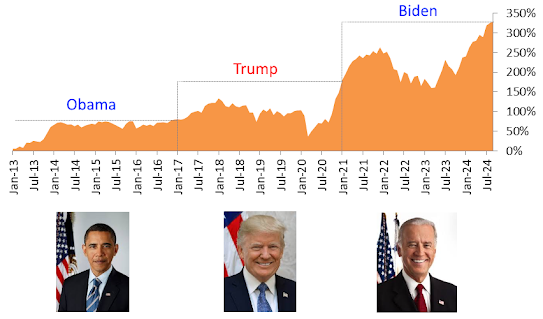.png)
And with three presidential elections in Incandescent Capital’s nascent history, maybe a chart of how your money has grown with me through three different administrations is closer to home:
.png)
As you can see, basically: politics don’t matter. Because corporations are not in the “business” of politics – they are in the business of adjusting to whatever the public policies are. At least, successful corporations worth investing in are. However the winds may blow, they set their sails profit-wards. This goes for us portfolio managers as well.
Most importantly, election day came and went, thankfully, once again, without any widespread unrest. The Trump administration redux will have less surprises for the world this time around. We can probably expect two things with high probability: less regulation, and more chaos. Keynesian animal spirits have been on full display in the days after November 6th, with the stock market expecting more unchecked growth and lower taxes. But on the flip side, the bond market has sold off, with yields rising on expectations of more inflation and higher deficits.
Look. It’s all mostly uncertainty and noise. Bottom line is, I urge you to not make economic decisions based solely on politics. I’ll remind you with the same anecdote I shared in my letter four years ago to-date:
“In 1951, I proposed to my wife. And my father-in-law was the most conservative guy in Nebraska except maybe for my dad. My father-in-law said, ‘I want to have a talk with you.’ So I went over to his house to have a talk. And he sat there and he said, ‘Warren,’ he says, ‘I just want to absolve you from any worries. You’re going to fail. And the reason you’re going to fail – my daughter may starve to death and you’re going to fail, but I’m not going to blame you – it’s because the Democrats are in and they’re all Communists.’ I listened to this thing for three hours. I have seen people make economic decisions based on their political feelings and it is not the way to do it.”-Warren E. Buffett, February 2017 1
_____________________________________
1 https://www.cnbc.com/2017/02/27/billionaire-investor-warren-buffett-speaks-with-cnbcs-becky-quick-on-squawk-box.html

